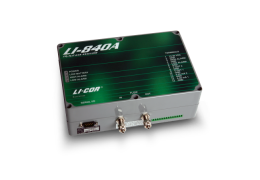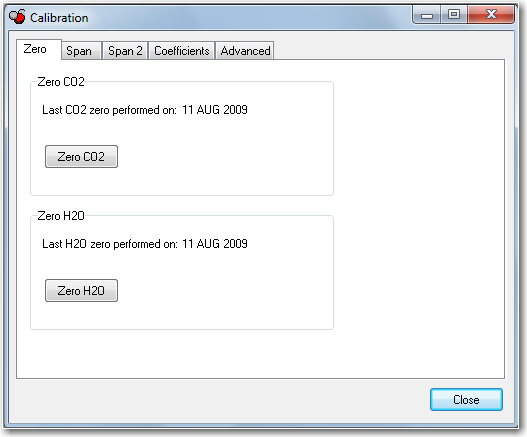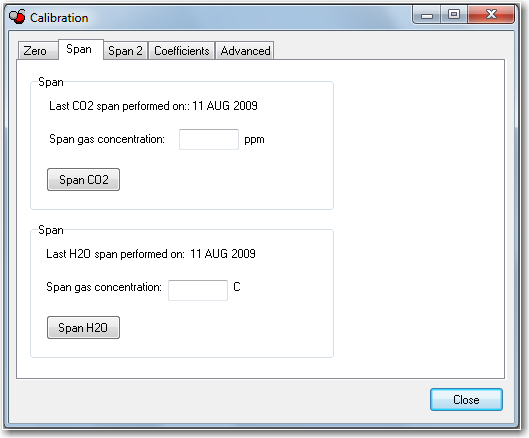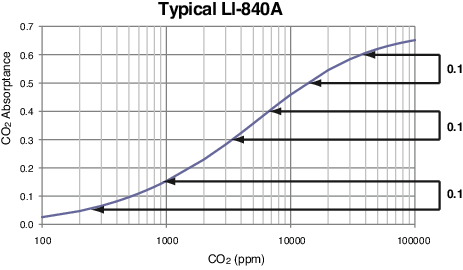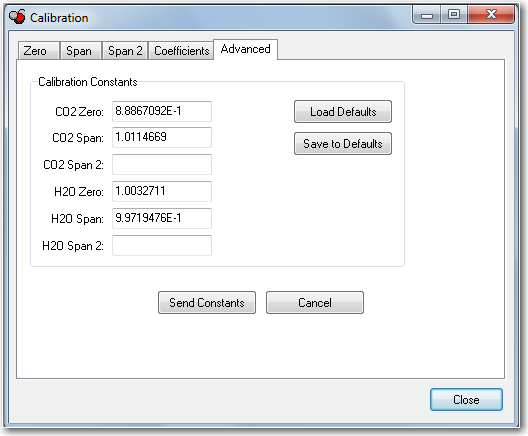Select Calibration from the View menu to open the Calibration window. This is the area in which you set the zero and spans of the LI-840A.
It is recommended that you perform the zero calibrations first, followed by the span calibrations. To zero, flow a dry, CO2-free gas through the LI-840A and make sure the optical cell is completely purged. Press the Zero CO2 button under the Zero tab.
The display will show ZERO, and the text in the Calibration window is grayed out. The zero will be set electronically, and the current date will be entered in the "Last CO2 zero performed on:" field when completed. Repeat for the H2O channel. Note: Purge the cell with the H2O zero gas for up to 15 minutes before zeroing H2O. Water vapor molecules are “sticky” and it may take up to 15 minutes to reach equilibrium in the optical cell.
To span, connect a span gas of known CO2 concentration to the input air stream. Make sure the cell is purged. Under the Span tab, enter the value of the span gas and click on Span CO2.
The display will show SPAN, for several seconds and the text in the Calibration window will be greyed out. The span will be set electronically, and the current date will be entered in the "Last CO2 span performed on:" field when completed. Note: Ensure that the CO2 standards are accurate, as this will determine the overall accuracy of the LI-840A.
Repeat for the H2O channel using an airstream of known dew point. Note: Purge the cell with the H2O span gas for up to 15 minutes before spanning H2O. The LI-610 Portable Dew Point Generator is capable of providing an airstream with a known water vapor concentration.
Two Point Span (Span 2 Tab)
Suppose you have two non-zero calibration gasses (e.g. CO2 at 300 ppm and 1500 ppm), and you use one of them (say, 1500 ppm) to set the span. If you then flow the other gas through the LI-840A, you would expect it to read within 1% of the expected value (in our example, 300 ±3 ppm). If it does not, you can adjust the calibration for this by performing a Secondary Span, by entering the span gas concentration and clicking the Span CO2 (Span 2 tab). After that, the 300 ppm tank should read 300, and the 1500 tank should still read 1500. This can also be performed with H2O if needed.
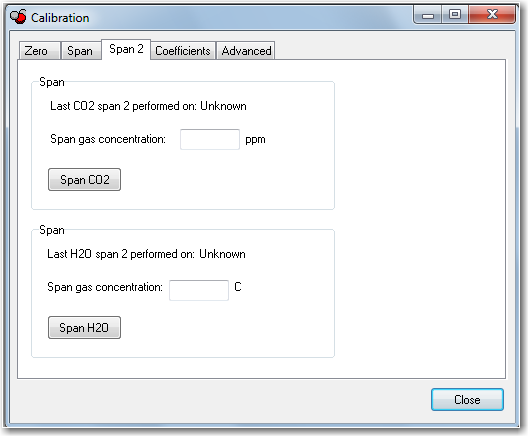
In the LI-840A version 2.0 and above, the span value is a linear function of absorptance, and thus has two parameters, a slope and an offset (see Equation Summary). Normal span setting adjusts the offset and leaves the slope alone. Setting the secondary span adjusts the slope, then adjusts the offset value for the new slope value. The slope and offset values can be viewed on the Advanced page. Span offset values (CO2 Span and H2O Span) are typically 1.0 ±0.1). Span slope values (CO2 Span 2 and H2O Span 2) are typically 0 ±0.1). When they are exactly 0, then slope is a constant, and not a function of absorptance.
The CO2 span slope value is first determined at the factory by setting the span at 200 ppm, and doing an secondary span close to 20000 ppm. This value should remain valid for some time. Things that are likely to make it change include changing the source and/or changing the detector, a dirty optical cell, and possibly even taking the optical bench apart for cleaning.
Considerations for performing a secondary span
- Zero first.
- After zeroing, do a (normal) span.
- The span and secondary span concentrations should be as far apart as possible and they should bracket the concentration range of interest to you. (e.g. 200 and 20000, or 300 and 1500, etc.). “Far apart” means in absorptance, not concentration. We recommend absorptance differences of at least 0.1 when choosing concentrations for setting span and secondary span.
For CO2, The difference in absorptance between 200 and 1000 ppm is typically about 0.1. There is also a 0.1 absorptance difference between 3500 and 7000 ppm, and between 15,000 ppm and 40,000 ppm. For H2O, it is a little harder to get a 0.1 absorptance difference. If you want to do a secondary span at room temperature, for example, the two span values would have to be 5 °C or less, and 22 °C, for example.
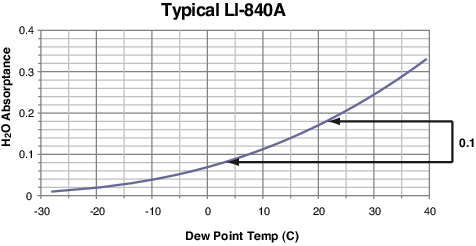
You can do multiple secondary spans after a normal span. For example, span at 200, then do a secondary span at 3000. Then (assuming you didn’t like the result for some reason), you can do another secondary span at 2000 ppm. As long as the secondary span is well away (in absorptance) from the previous normal span, it is OK to do as many consecutive secondary spans at various concentrations as you’d like.
Coefficients Page
The LI-840A uses a double rectangular hyperbola for the CO2 calibration, and a third order polynomial for H2O calibration. The Coefficients page displays these factory-determined calibration coefficients, as well as those for band broadening and cross sensitivity, and coefficients for the internal pressure transducer. These coefficients are fixed at the factory.
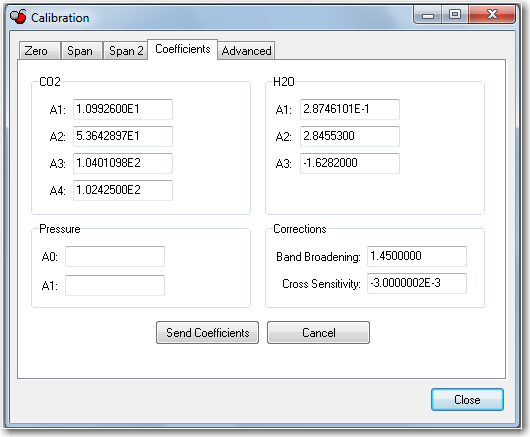
The calibration coefficients are unique to each instrument, and may be found on the calibration sheet shipped from the factory. In most cases you will not want to alter any of these values.
A description of the band broadening can be found in Appendix B, Equation Summary.
Advanced Page
The calibration constants for CO2 and H2O zero and span calibrations are found on the Advanced calibration page. These constants are stored to a file on the computer by clicking on Save to Defaults. Click Load Defaults to restore the values in this window using the file on the PC. If new constants are entered in this window, click Send Constants to send the values to the LI-840A for implementation.
In most cases you should not change the values in this window; see Symbol Summary for a description of the terms used in this window.
